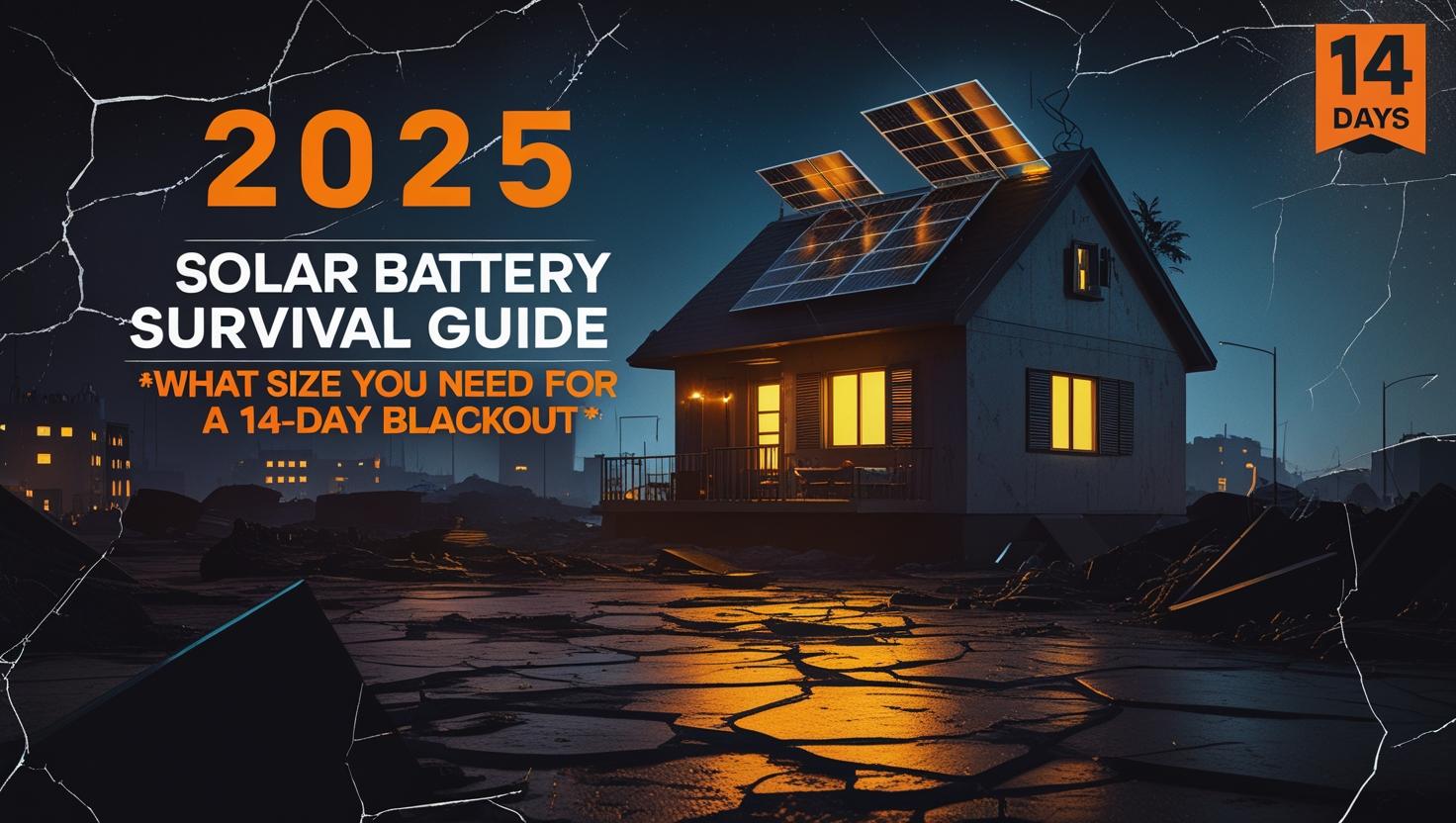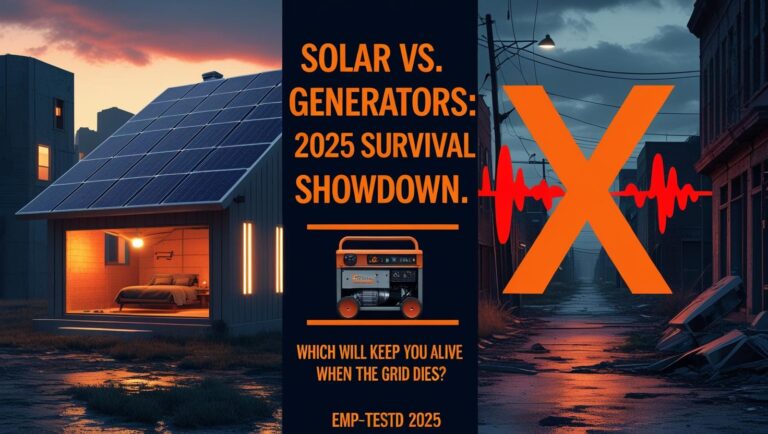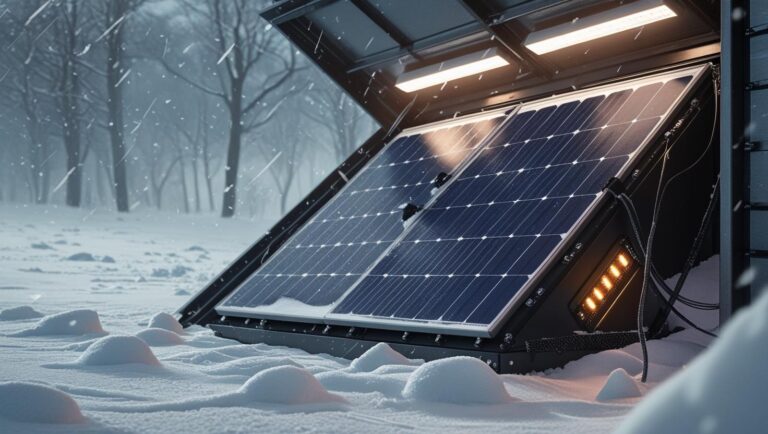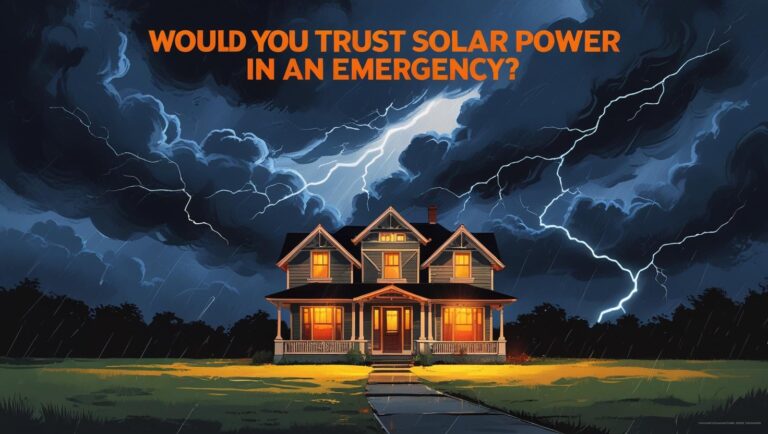Solar Power in Emergencies: A Reliable Backup or a Risky Gamble
⚡ Introduction
When the grid fails, most panic—but what if your lights, fridge, and phone stayed on? Solar power promises energy independence, but can it truly deliver in a crisis? Let’s cut through the hype and explore the real strengths, limitations, and survival-ready setups for solar power in emergencies.
🔋 Why Trust Solar in an Emergency?
Solar isn’t perfect, but it’s a game-changer for resilience:
- ✅ No Fuel Needed: Unlike gas generators, solar runs on sunlight (free and infinite).
- ✅ Silent & Low-Maintenance: No noise, fumes, or weekly refueling.
- ✅ Scalable: Power anything from a phone (with a $100 portable panel) to a full home (with a battery system).
Real-World Proof:
After Hurricane Maria, solar-powered homes in Puerto Rico kept lights on for weeks while the grid was down.
(Source: National Renewable Energy Lab).
⚠️ Potential Risks & Limitations
Solar has critical dependencies:
- ☁️ Weather: Output drops 50–90% on cloudy/stormy days.
- 🔋 Storage Limits: Most home batteries last 1–3 days without sun.
- 💸 Upfront Cost: A full backup system costs $10K–$30K (vs. $500 for a gas generator).
Pro Tip: Pair solar with a small gas generator for “hybrid resilience.”
🛠️ How to Optimize Solar for Emergencies
Must-Have Components:
| Component | Purpose | Budget Option |
|---|---|---|
| Solar Panels | Generate power | Renogy 100W Panel ($120) |
| Deep-Cycle Batteries | Store energy | Battle Born LiFePO4 ($900) |
| Inverter | Convert to AC power | Giandel 1200W ($160) |
3 Emergency Prep Steps:
- Pre-Charge Batteries before storms hit.
- Prioritize Loads: Run fridges/lights, skip AC.
- Test Regularly: Simulate outages to find weak points.
🔥 Solar Survival Scenarios: Real-World Readiness
Urban Blackout (72-Hour):
- Minimum Setup: 100W panel + 1kWh battery (runs LED lights, phone, mini-fridge).
- Pro Tip: “Use USB-powered fans to avoid draining batteries with AC.”
Off-Grid Crisis (2-Week):
- Critical Gear:
- Renogy 400W Kit + 2x EcoFlow Delta batteries.
- Hand pump for well water (solar powers UV purifier).
Post-Collapse Long-Term:
- DIY Fixes: Salvage panels from road signs, use vinegar to clean corrosion.
- Warning: *”Avoid lead-acid batteries—lifespan drops 50% in freezing temps.”*
🛠️ The Survivalist’s Solar Toolkit
| Gear | Purpose | Survival Rating |
|---|---|---|
| BioLite SolarPanel 10+ | Stealth charging | ⭐⭐⭐⭐ |
| PowerFilm LightSaver | EMP-resistant | ⭐⭐⭐⭐⭐ |
| DIY Solar Oven | Cook without smoke (avoids detection) | ⭐⭐⭐ |
⚡ Psychological Edge: Solar as a Force Multiplier
- Stealth Mode: “Blackout curtains + infrared filters hide LED glow at night.”
- Barter Proof: “In 2022 Texas freeze, one prepper traded 10 phone charges for a week’s food.” (Source: OffGrid Magazine)
💀 The Dark Side: When Solar Fails
Case Study: “2023 Arizona Monsoon: Dust reduced output to 12%—survivalists switched to wind turbines.”
Redundancy Plan:
- Gas generator (last resort).
- Hand-crank radio (for alerts).
| Scenario | Solar Viability (1-5) | Key Gear |
|---|---|---|
| Urban Riot | ⭐⭐⭐⭐ | Foldable 50W panel |
| EMP Event | ⭐ | Faraday-caged battery |
📊 Solar vs. Generator: Emergency Comparison
| Solar + Battery | Gas Generator | |
|---|---|---|
| Runtime | 1–3 days (depends on sun/battery size) | Unlimited (with fuel) |
| Cost | $10K–$30K (whole home) | $500–$3K |
| Maintenance | Minimal (clean panels annually) | Monthly oil changes |
FAQs
Will solar work at night or during storms?
Solar panels need sunlight, but batteries store excess energy. For long storms, conserve power or supplement with a generator.
How long can solar power a home in an emergency?
Depends on battery size and usage. A 10kWh battery can run basics (lights, fridge, phone) for 1–3 days.
Emergency Solar Power: Survivalist FAQs
Will solar panels work during a multi-day storm or hurricane?
Yes, but with reduced output (10-25% of normal power) during cloudy days.
- Pre-charge batteries to 100% before the storm hits
- Use a hybrid system with a gas generator for backup
- Conserve power by prioritizing essential devices only
How much solar power do I need to run a refrigerator in an emergency?
| Fridge Type | Wattage | Required Solar Setup |
|---|---|---|
| Mini-fridge | 50-100W | 200W panel + 1kWh battery |
| Full-size | 150-300W | 400W panel + 2kWh battery |
Pro Tip: Add 20% extra capacity for startup surges.
Can I use car batteries for emergency solar storage?
Possible but risky – lead-acid car batteries:
- Only use 50% of capacity (vs. 80% for deep-cycle)
- Last 1/3 as long as lithium batteries
- Require more maintenance
Better option: Battle Born LiFePO4 (10x lifespan)
How do I protect my solar system from EMP attacks?
3-layer protection:
- Panels: Naturally EMP-resistant (no electronics)
- Controller/Inverter: Store in a Faraday cage
- Wiring: Use shielded cables when possible
What’s the absolute cheapest solar setup for emergency lighting?
$75 Survival Lighting Kit:
- 20W Solar Panel ($35)
- 12V 7Ah Battery ($25)
- LED Strip Lights ($15)
Runtime: 8 hours/night for 3 days
How can I hide my solar panels from looters?
Stealth tactics:
- Paint panels matte green/gray to blend with surroundings
- Mount on north-facing roof (less visible from ground)
- Use camo netting to break up outlines
- Install in less obvious locations (backyard vs. front roof)
Will solar work in freezing temperatures?
Yes, but with caveats:
- Panels: More efficient in cold (but snow cover reduces output)
- Batteries: Lithium loses 20% capacity below freezing – insulate batteries
- Wiring: Use cold-rated cables that won’t become brittle
Can I run medical equipment (CPAP, oxygen) on solar?
| Device | Wattage | Required Battery |
|---|---|---|
| CPAP | 30-60W | 2kWh for 3 nights |
| Oxygen Concentrator | 300-600W | 10kWh+ |
Warning: Always have a backup power source for critical medical devices!
How do I maintain my solar system with no grid power?
Monthly survival maintenance checklist:
- Clean panels with vinegar/water solution
- Check battery terminals for corrosion (clean with baking soda paste)
- Test system with a load tester
- Inspect wiring for rodent damage
- Check charge controller settings
What’s the #1 mistake survivalists make with solar?
Assuming “set and forget”:
Solar requires active management during emergencies:
- Monitor battery levels daily
- Adjust consumption based on weather forecasts
- Have redundant charging methods (hand crank, generator)
- Practice energy discipline – prioritize essentials only
- Test systems regularly before emergencies occur




